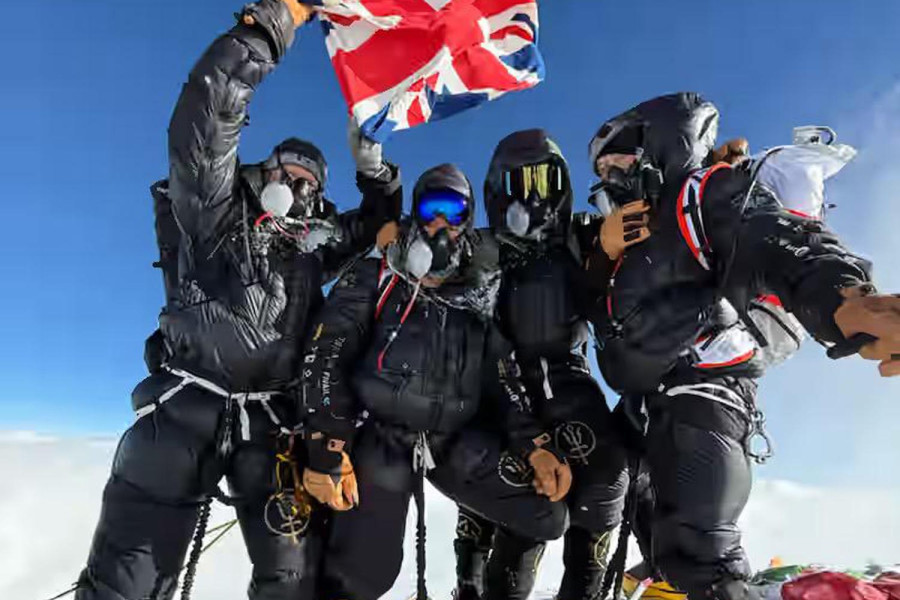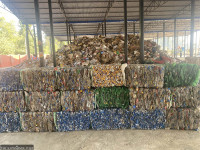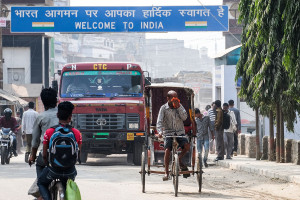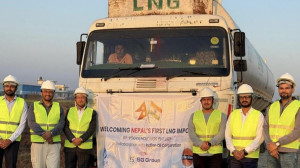Money
Everest in five days: British team’s speed climb triggers probe
Ex-special force soldiers climb in record time after xenon gas treatment in Germany. Nepal launches an inquiry.
Sangam Prasain
Four former British special forces soldiers have set a startling new precedent on Mount Everest, reaching the summit in under five days without the traditional acclimatisation process. Their rapid ascent of the planet’s tallest peak has drawn sharp scrutiny from Nepali authorities, not for the climb itself, but for the controversial use of xenon gas prior to their arrival in Nepal.
The team, comprising Major Garth Miller, Colonel Alistair Scott Carns, Anthony James Stazicker, and Kevin Francis Godlington, summited the world’s highest peak at approximately 7:15 am on Wednesday.
Their journey began in London on the afternoon of May 16, with the climbers arriving at Everest Base Camp the following day. By 10:30 pm on May 20, they had begun their final summit push.
Back home, the team had trained in hypoxic tents and followed a rigorous high-altitude conditioning regime. But what has provoked the current controversy is their reported inhalation of xenon gas, administered two weeks before departure in Europe, intended to reduce the risk of altitude sickness.
Himal Gautam, director of the Department of Tourism, who oversees mountaineering expeditions, said the department was not informed of the gas use.
“We have launched an investigation into the matter,” he said, noting that all climbers and operators must declare the equipment, medications, and substances used during expeditions.
Traditionally, climbers take more than a month to summit Everest. They begin their trek in early April and complete multiple rotations between Everest Base Camp and higher camps to acclimatise. These rotations are vital for adapting to the thinning air at high altitudes, and skipping them is considered risky.
By contrast, the British team completed the entire climb in just five days—a feat that would have been unimaginable in previous decades.
While their speed has captivated parts of the global mountaineering community, it has triggered a heated debate in Nepal about safety, ethics, and the future of high-altitude climbing.
The expedition was organised by the Austria-based Furtenbach Adventures, whose founder, Lukas Furtenbach, insists the team followed all rules. He confirmed that the xenon treatment was administered in Germany and emphasised that only standard supplemental oxygen was used on the mountain.
“What happens outside Nepal should not be under the purview of the Nepal government,” he said.
He defended xenon’s use as a modern, medically supervised intervention to prevent altitude sickness and suggested it could make Himalayan expeditions safer. “Our company has a long-standing reputation for safety,” Furtenbach said, expressing confidence that the investigation would find no wrongdoing.
He also pointed to potential environmental benefits. “Shorter expeditions mean less garbage, lower carbon emissions, and reduced human waste in the fragile alpine ecosystem,” he argued. Despite the abbreviated climb, Furtenbach claimed his team employed about 120 local workers and paid them competitively, demonstrating, in his view, that sustainability and economic benefit could go hand in hand.
Yet not all stakeholders are convinced.
Dambar Parajuli, president of the Expedition Operators Association of Nepal, warned that widespread adoption of such short-duration climbs could upend the economic model on which the Everest industry depends.
“Traditional expeditions employ sherpas, porters, guides, and kitchen staff for weeks, sometimes months,” he said. “If climbers finish their journey in days, the ripple effect on local employment will be devastating.”
He urged the government to consider the broader implications of this shift and to ensure that new policies uphold the livelihoods of communities that depend on the Everest economy.
Xenon’s use further complicates matters.
In 2014, the World Anti-Doping Agency (WADA) banned the gas for athletes, citing its potential to enhance performance by stimulating the production of erythropoietin (EPO). This hormone boosts red blood cell production. However, mountaineering does not fall under WADA’s purview, and there is no ban on its use for non-competitive climbers.
In January, the International Climbing and Mountaineering Federation (UIAA) released a statement on xenon, concluding that it offers no proven performance benefit for altitude climbing.
“Although a single dose may cause a short-term spike in EPO levels, there is no evidence that this translates into increased red blood cell count or improved performance,” the UIAA said. It emphasised that acclimatisation is a complex physiological process that a single intervention cannot hack.
Moreover, the UIAA warned that xenon is a potent anaesthetic, not widely approved for medical use, and carries health risks. “In an unmonitored environment like Everest, side effects such as impaired brain function or respiratory distress could be fatal,” the statement said.
One study cited by the UIAA reported significant sedation even at doses recommended for mountaineering, posing a potentially serious risk in high-altitude zones where alertness can mean the difference between life and death.
Still, Furtenbach dismissed these concerns.
He said his company followed ethical and medical guidelines and remained open to cooperation with Nepali authorities. “We are transparent and willing to share our expertise with the government. But there needs to be a better understanding of modern medical science,” he said.
The Everest “death zone,” above 8,000 metres, is one of the most hostile environments on Earth.
Oxygen is scarce; even seasoned climbers risk pulmonary or cerebral oedema, frostbite, and exhaustion. That such terrain could be tackled in mere days through science and training challenges deeply held beliefs about human endurance and the ethics of high-altitude mountaineering.
As Nepal’s investigation proceeds, officials face a new dilemma: how to regulate innovation without sacrificing safety, fairness, or the economic sustainability of Everest expeditions.




 13.12°C Kathmandu
13.12°C Kathmandu















